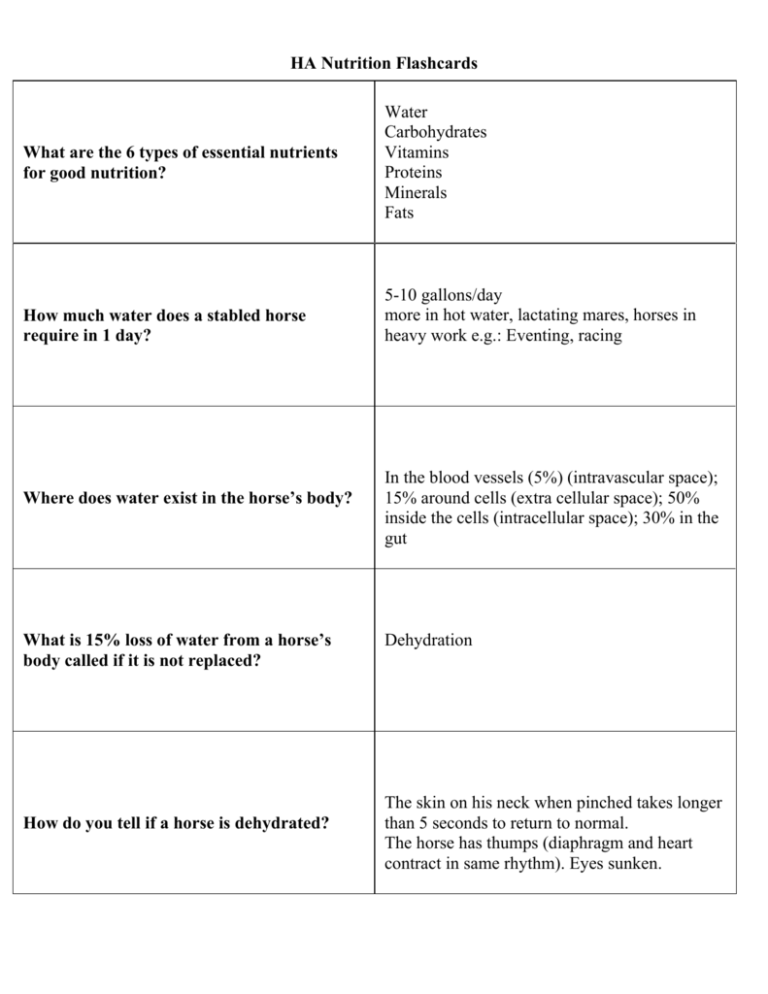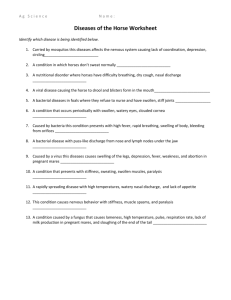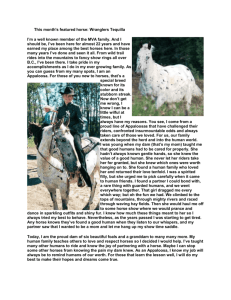HA Nutrition Flashcards What are the 6 types of essential nutrients
advertisement

HA Nutrition Flashcards What are the 6 types of essential nutrients for good nutrition? How much water does a stabled horse require in 1 day? Where does water exist in the horse’s body? What is 15% loss of water from a horse’s body called if it is not replaced? How do you tell if a horse is dehydrated? Water Carbohydrates Vitamins Proteins Minerals Fats 5-10 gallons/day more in hot water, lactating mares, horses in heavy work e.g.: Eventing, racing In the blood vessels (5%) (intravascular space); 15% around cells (extra cellular space); 50% inside the cells (intracellular space); 30% in the gut Dehydration The skin on his neck when pinched takes longer than 5 seconds to return to normal. The horse has thumps (diaphragm and heart contract in same rhythm). Eyes sunken. HA Nutrition Flashcards Name possible causes for dehydration. What are carbohydrates and what foods contain them? Which has more concentrated carbohydrates –hence more energy per pound of food – hay or grain How would a horse act if he were deficient in carbohydrates? Rank the following from highest to lowest in carbohydrates: oats/barley/corn/,alfalfa/grass hay/flax seed/beet pulp Hot weather and no water Diarrhea Overwork in hot weather with excessive sweating Fever and sweating Ice on water trough and no water Nutrients that are made up of sugars, starches and cellulose Hays and grains grain Tired, lethargic, no energy, thin Flax seed → corn→ barley→ oats→ beet pulp→ alfalfa hay→ grass hay HA Nutrition Flashcards In General: What % of horse’s body weight is required in feed daily? Horse in light to heavy work Pregnant mares in last 3 months and young horses Horses in light to heavy work 1.5 -3% of body weight Pregnant mares and young horses 2.5-3% of body weight Nervous System Diseases: Botulism Cause: Toxin produced by Clostridium Botulinum Found: when animal carcasses baled in hay – Symptoms: 3-7 days after ingestion, paralysis of tongue and jaw, drooling, inability to swallow, weakness, shuffling gait, paralysis, death due to paralysis of the respiratory muscles, causes shaker foal syndrome Prevention: Vaccination Treatment: supportive (keep animal warm, tube feed) Nervous System Diseases: Equine Encephalomyelitis Sleeping Sickness EEE, WEE, VEE Cause: Virus carried in blood transmitted by infected birds to humans or horses thru mosquito bite Found: All over Symptoms: Fever, drowsiness, circling, pressing head against wall, paralysis, death, survivors often have permanent brain damage. Prevention: Vaccination (once a year) Treatment: Supportive Nervous System Diseases: Rabies Cause: Rabies Virus (transmitted by bite of rabid animal) Found: everywhere Symptoms: Facial paralysis, lameness, colic, faulty vision, personality change, head pressing, Always fatal Prevention: Vaccination (once a year) Treatment: none (supportive) HA Nutrition Flashcards What are proteins made up of? 22 amino acids 10 essential 12 non-essential What are the 10 essential amino acids? Arginine, lysine, leucine, isoleucine, Histidine, methionine, phenylalanine, threonine, tryptophan, valine What are proteins used for? To make: blood proteins (albumin, antibodies etc), hair, hooves, muscle, organs (such as heart/lungs, kidney liver etc), skin, milk, enzymes, cell walls –almost everything in the horse’s body. What is the average % of protein in Grade 1 oats? 12% What % of horse’s body weight is made up of protein? 22% HA Nutrition Flashcards What % protein is recommended for: Weanlings Lactating mares 2 year olds Pregnant mares Mature horses in light work Mature horses in no work -Weanlings = 14-16% -Lactating mares = 14% -2 year olds = 10-12% -Pregnant mares = 8-13% -Adult horses light work = 7-8% -Adult horses no work = 7-8% What is the general % of protein in midbloom alfalfa? 17% What is general % of protein in grass/oat hays? What is the general % in pasture grass? Hays (grass/oat) 8-8.5% Pasture grass 2.8-3% What might you expect a horse to look like if he were deficient in protein? Hair loss with thinning mane and tail No Energy HA Nutrition Flashcards What problems can excessive protein lead to? Kidney or liver damage Fats should compose what % of a horse’s daily ration? 2-3% List in order highest fat content to lowest alfalfa, rice bran, corn oil, oats, flax seed, corn Highest to Lowest: corn oils (100%)– rice bran (20%)– flax seed (18%)- oats (4.5%) – corn (3.5%)- alfalfa (2.5%) Fats are essential for: -Aid in absorption of fat soluble vitamins -Provide energy ( 9 cal/gm of fat) -Store energy -Spare protein being metabolized for energy -Important source of energy in mare’s milk -Increases tastiness of food supplements -Increases stamina in performance horses HA Nutrition Flashcards What are the 2 classes of vitamins? Fat Soluble Water Soluble Name the fat soluble Vitamins A, D, E, K Name the water soluble Vitamins Vitamin B complex vitamins Vitamin C What are some of the differences between the water and fat soluble vitamins are: Fat Soluble vitamins can be stored in the body – therefore, can be overfed and cause toxicity problems Water soluble vitamins must be fed everyday Which vitamins maintain healthy skin, eyes, mucous membranes and bones? Vitamin D (promotes absorption of Calcium – sunshine vitamin) Vitamin A – maintains healthiness of skin, mucous membranes, promotes good vision (especially night vision) – present in large amounts in carrots –also found in hays and grains and complete feeds –as well as vitamin supplements HA Nutrition Flashcards Name the 6 macro minerals (needed in large amounts). Calcium, Potassium, Sodium, Chloride, Phosphorous, Magnesium Name 6 micro minerals (Trace Elements). Iron, Zinc, Copper, Fluoride, Iodine, Selenium, Cobalt, Sulfur, Manganese Name the 2 most common minerals found in the body. Calcium and Phosphorous (Bone) Calcium:Phosphorous ratio Ideal: Must be less than: Ideal 2:1 Keep less than 3:1 Main electrolytes found in extra cellular fluid and plasma Sodium and Chloride (Salt) What trace mineral is necessary for normal thyroid function? Iodine








